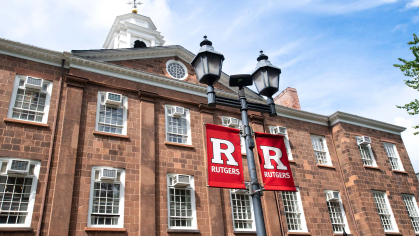Rutgers University–New Brunswick Launches New Financial Aid Program to Increase Access and Affordability for In-State Students

Scarlet Guarantee to sharply drop net tuition and fees for estimated 7,600 students
Rutgers University–New Brunswick announced today a sweeping new financial aid program that builds upon existing state aid programs to enable New Jersey students with family incomes below $65,000 to attend the university tuition free. The program also provides a sliding scale that significantly limits the amount of out-of-pocket tuition and fees paid by students with family incomes below $100,000.
The Scarlet Guarantee will be available to first- and second-year students and is linked to the Garden State Guarantee, a new statewide program launched last month by New Jersey Governor Phil Murphy for third- and fourth-year students. An estimated 7,600 students at Rutgers University-New Brunswick are expected to take advantage of the programs.
“These new programs are transformational for our state’s students,” said Rutgers University–New Brunswick Chancellor-Provost Francine Conway. “Students who once thought a college education could never be within reach will have the access and opportunity to fulfill their life’s ambition. I couldn’t be more thrilled that Rutgers-New Brunswick will now be more inclusive of all students.”
In combination with the Garden State Guarantee, the Scarlet Guarantee will provide the following coverage for undergraduate students for four years:
- Adjusted Gross Income of $65,000 or less: Full annual tuition and mandatory fees
- Adjusted Gross Income of $65,001 to $80,000: Students will pay no more than $3,000 per year toward tuition and mandatory fees
- Adjusted Gross Income of $80,001 to $100,000: Students will pay no more than $5,000 per year toward tuition and mandatory fees
“I applaud President Holloway and Chancellor-Provost Conway for their bold initiative to put a Rutgers undergraduate education within reach for more students," said New Jersey Gov. Phil Murphy. "The Scarlet Guarantee builds upon the foundation of our Garden State Guarantee program and is a game changer for the Rutgers community. I look forward to seeing other colleges and universities across New Jersey take similar steps to make college more affordable.”
The program provides “last dollar” financial aid that covers the gap in the cost of in-state tuition and mandatory fees after other state and federal aid programs are provided to qualified students.
“The Scarlet Guarantee program will help qualified students from across New Jersey realize their hopes, dreams and ambitions and will help Rutgers become an even richer and more diverse university,” said Rutgers President Jonathan Holloway.
Students are automatically considered for the Scarlet Guarantee when they complete the Free Application for Federal Student Aid (FAFSA) or, if they qualify as a New Jersey Dreamer, the NJ Alternative Financial Aid Application.
The Garden State Guarantee was signed into law by Governor Phil Murphy and will be first implemented in the 2022-23 academic year.
“A Rutgers degree will open so many doors, and many more students can now pursue all the opportunities afforded by a world-class research university without worrying about whether they can afford it,” said Courtney McAnuff, vice chancellor for enrollment management at Rutgers–New Brunswick. “We are deeply appreciative of Gov. Murphy’s commitment to making college more affordable and are happy to join his efforts.”
Rutgers–New Brunswick is New Jersey’s top-ranked public university and is regularly ranked among the best public research universities in the world. In recent years, it has redoubled its commitment to increasing pathways for its 35,000 undergraduate students, who come from all economic backgrounds.
The announcement comes at an apt time for the university as it celebrates its ninth annual Access Week. From Feb. 21 -25, student-facing programming and lectures on campus will focus on how the university can champion educational equity and unlock pathways for success for current and prospective first-generation, low-income and other underserved students.


